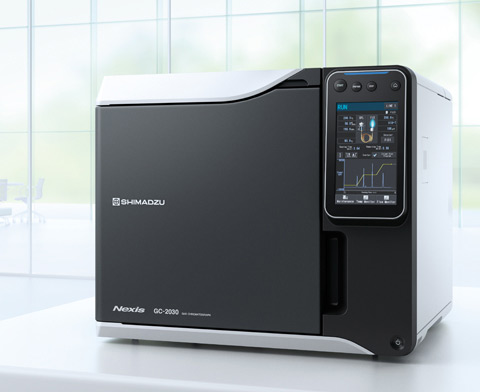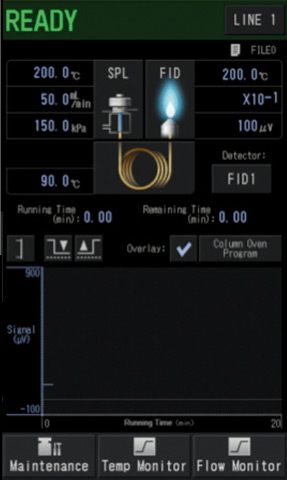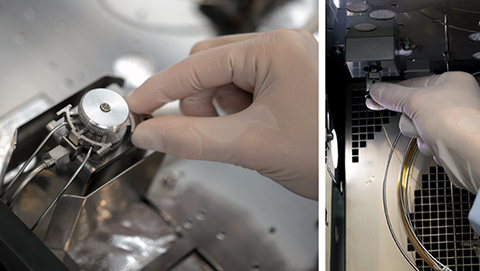The Next Industry Standard
Nexis GC-2030 – a new milestone in precision and sensitivity
 Figure 1: Milestones in GC development – Nexis GC-2030
Figure 1: Milestones in GC development – Nexis GC-2030
It has been 60 years since Shimadzu initiated the development of GC systems with the introduction of its GC-1A. Since then, numerous innovations have made gas chromatography one of the most important analytical techniques. Based on longstanding experience in the development of GC systems as well as continuous exchange of ideas with users, Shimadzu has set a new milestone in precision and sensitivity with its Nexis GC-2030.
The Nexis GC-2030 stands for ‘Next Industry Standard.’ Meeting this demand requires a clear view of present day GC requirements. Gas chromatography is used in all areas of research and development that ultimately enrich but also influence our daily life through foods, consumer goods, electronics, health and environment. Growing concern over the extent to which technological advances negatively influence people and the environment has led to an increased demand to learn more about the complex composition of products as well as their emission into the environment and their resulting interactions.
To meet these demands, an analysis system must fulfill many requirements:
- chromatographic solutions for separation of complex samples
- high detection sensitivity for the smallest traces of toxic impurities
- highest precision for reliable results
- simple instrument control and operation, also for novice GC users
- high reliability supported by automated diagnostic routines
- safety when handling hydrogen carrier gas.
Simple operation via self-explanatory user interface
The new color touchscreen display offers fast and intuitive access to the Nexis GC-2030. Self-explanatory icons guide users through the entire system operation (figure 2). The same icons are found in the new LabSolutions software, which offers optional conventional or graphically controlled operation of the GC. Network-operated control also offers all advantages of the World Wide Web. Direct access via iPhone or iPad to the status of an ongoing analysis as well as launching of new measurement sequences is possible at any time and any place.
 Figure 2: Color display with the Nexis GC-2030 touchscreen
Figure 2: Color display with the Nexis GC-2030 touchscreen
Maintenance without tools
Regular maintenance tasks on the Nexis GC-2030 such as septum, liner and column replacement no longer require any tools and can be performed quickly and efficiently (figure 3a). The new Click Tek connector technology also enables simple column installation by hand without the use of any tools. An optional oven lamp is available for illumination and offers an excellent view inside the oven (figure 3b).
 Figure 3a and 3b: Maintenance without tools: liner replacement of the split injector (SPL) or column installation in the GC oven. The optional oven light facilitates these steps by providing good illumination of the column connections.
Figure 3a and 3b: Maintenance without tools: liner replacement of the split injector (SPL) or column installation in the GC oven. The optional oven light facilitates these steps by providing good illumination of the column connections.
Flexible choice of carrier gas control with highest precision
Intelligent and ultrafast carrier gas control (AFC – Advanced Flow Control) enables superior reproducibility of the Nexis GC-2030 through high-precision gas flow rate control. Carrier gas flow can be adjusted and controlled based on constant linear velocity, volume flow or pressure.
Highest sensitivity worldwide
Redesigned detectors such as the flame ionization detector (FID), electron capture detector (ECD) and flame photometer (FPD) open up new dimensions in trace analysis. The unique barrier ionization discharge (BID) detector allows simultaneous detection of inorganic and organic components in the low-ppb range.
Efficiency for fast results and high sample throughput
Special techniques such as backflushing, detector splitting and heartcutting are supported by the GC system and can be integrated into the chromatographic configuration as simple modules. In this way, the graphical support allows easy access to advanced chromatographic techniques.
Fast GC is the technique of choice for obtaining fast results or high sample throughput. High-resolution capillary columns allow separation of complex samples in the shortest amount of time by using high carrier gas flow velocities and high heating rates of the GC oven.
This, however, requires an ultrafast responding detector system in order to capture sharp signals at full height and symmetry. Each detector of the Nexis GC-2030 system can be adjusted optimally to any chromatographic technique by setting the data acquisition rate (up to 500 Hz) and the filter time constant (2 – 2,000 ms).
Safety with hydrogen as carrier gas
For most GC applications and particularly for fast ones, hydrogen is the ideal carrier gas. However, its use presents risks in the event of leakages.
The Nexis GC-2030’s automatic gas leak check assures adequate safety.
A residual risk remains at higher gas flows in low pressure ranges. Here, the optional hydrogen sensor offers additional safety. The GC-2030 oven is monitored continuously and the GC system is shut down before an explosive hydrogen concentration can form.Summary
Over the past decades, gas chromatography has developed into a comprehensive technique. With the Nexis GC-2030, Shimadzu makes this available to every user. Simple self-explanatory operation facilitates access for ‘GC novices’ intending to use GC analytical technologies in their fields of expertise. Sensitive detectors also measure in the ultra-trace range with highest precision. Sophisticated diagnostic techniques provide information on the system’s operational capability at any time. Daily tasks are carried out with just a few steps. Safety for economical operation using hydrogen as carrier gas is assured via optional sensors. As the new standard, the Nexis GC-2030 combines high performance with simple operating conditions and reliable long-term operation.